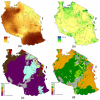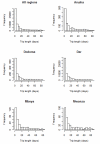The use of mobile phone data for the estimation of the travel patterns and imported Plasmodium falciparum rates among Zanzibar residents
- PMID: 20003266
- PMCID: PMC2800118
- DOI: 10.1186/1475-2875-8-287
The use of mobile phone data for the estimation of the travel patterns and imported Plasmodium falciparum rates among Zanzibar residents
Abstract
Background: Malaria endemicity in Zanzibar has reached historically low levels, and the epidemiology of malaria transmission is in transition. To capitalize on these gains, Zanzibar has commissioned a feasibility assessment to help inform on whether to move to an elimination campaign. Declining local transmission has refocused attention on imported malaria. Recent studies have shown that anonimized mobile phone records provide a valuable data source for characterizing human movements without compromising the privacy of phone users. Such movement data in combination with spatial data on P. falciparum endemicity provide a way of characterizing the patterns of parasite carrier movements and the rates of malaria importation, which have been used as part of the malaria elimination feasibility assessment for the islands of Zanzibar.
Data and methods: Records encompassing three months of complete mobile phone usage for the period October-December 2008 were obtained from the Zanzibar Telecom (Zantel) mobile phone network company, the principal provider on the islands of Zanzibar. The data included the dates of all phone usage by 770,369 individual anonymous users. Each individual call and message was spatially referenced to one of six areas: Zanzibar and five mainland Tanzania regions. Information on the numbers of Zanzibar residents travelling to the mainland, locations visited and lengths of stay were extracted. Spatial and temporal data on P. falciparum transmission intensity and seasonality enabled linkage of this information to endemicity exposure and, motivated by malaria transmission models, estimates of the expected patterns of parasite importation to be made.
Results: Over the three month period studied, 88% of users made calls that were routed only through masts on Zanzibar, suggesting that no long distance travel was undertaken by this group. Of those who made calls routed through mainland masts the vast majority of trips were estimated to be of less than five days in length, and to the Dar Es Salaam Zantel-defined region. Though this region covered a wide range of transmission intensities, data on total infection numbers in Zanzibar combined with mathematical models enabled informed estimation of transmission exposure and imported infection numbers. These showed that the majority of trips made posed a relatively low risk for parasite importation, but risk groups visiting higher transmission regions for extended periods of time could be identified.
Conclusion: Anonymous mobile phone records provide valuable information on human movement patterns in areas that are typically data-sparse. Estimates of human movement patterns from Zanzibar to mainland Tanzania suggest that imported malaria risk from this group is heterogeneously distributed; a few people account for most of the risk for imported malaria. In combination with spatial data on malaria endemicity and transmission models, movement patterns derived from phone records can inform on the likely sources and rates of malaria importation. Such information is important for assessing the feasibility of malaria elimination and planning an elimination campaign.
Figures







Similar articles
-
Travel risk, malaria importation and malaria transmission in Zanzibar.Sci Rep. 2011;1:93. doi: 10.1038/srep00093. Epub 2011 Sep 15. Sci Rep. 2011. PMID: 22355611 Free PMC article.
-
Risk of imported malaria infections in Zanzibar: a cross-sectional study.Infect Dis Poverty. 2023 Aug 28;12(1):80. doi: 10.1186/s40249-023-01129-5. Infect Dis Poverty. 2023. PMID: 37641152 Free PMC article.
-
Strong isolation by distance and evidence of population microstructure reflect ongoing Plasmodium falciparum transmission in Zanzibar.Elife. 2024 Jun 27;12:RP90173. doi: 10.7554/eLife.90173. Elife. 2024. PMID: 38935423 Free PMC article.
-
Mobile phones and malaria: modeling human and parasite travel.Travel Med Infect Dis. 2013 Jan-Feb;11(1):15-22. doi: 10.1016/j.tmaid.2012.12.003. Epub 2013 Mar 9. Travel Med Infect Dis. 2013. PMID: 23478045 Free PMC article. Review.
-
Human movement data for malaria control and elimination strategic planning.Malar J. 2012 Jun 18;11:205. doi: 10.1186/1475-2875-11-205. Malar J. 2012. PMID: 22703541 Free PMC article. Review.
Cited by
-
Travel risk, malaria importation and malaria transmission in Zanzibar.Sci Rep. 2011;1:93. doi: 10.1038/srep00093. Epub 2011 Sep 15. Sci Rep. 2011. PMID: 22355611 Free PMC article.
-
Integrating mobility, travel survey, and malaria case data to understand drivers of malaria importation to Zanzibar, 2022-2023.medRxiv [Preprint]. 2025 Jul 25:2025.06.04.25327997. doi: 10.1101/2025.06.04.25327997. medRxiv. 2025. PMID: 40502588 Free PMC article. Preprint.
-
Surveillance considerations for malaria elimination.Malar J. 2012 Aug 31;11:304. doi: 10.1186/1475-2875-11-304. Malar J. 2012. PMID: 22938625 Free PMC article.
-
A framework for assessing the feasibility of malaria elimination.Malar J. 2010 Nov 11;9:322. doi: 10.1186/1475-2875-9-322. Malar J. 2010. PMID: 21070659 Free PMC article. Review.
-
Preventing the reintroduction of malaria in Mauritius: a programmatic and financial assessment.PLoS One. 2011;6(9):e23832. doi: 10.1371/journal.pone.0023832. Epub 2011 Sep 2. PLoS One. 2011. PMID: 21912645 Free PMC article.
References
-
- Pampana E. A textbook of malaria eradication. Oxford: Oxford University Press; 1963.
-
- World Health Organization. Global malaria control and elimination: report of a technical review. Geneva: World Health Organization; 2008.
Publication types
MeSH terms
Grants and funding
LinkOut - more resources
Full Text Sources
Other Literature Sources
Medical
Miscellaneous

